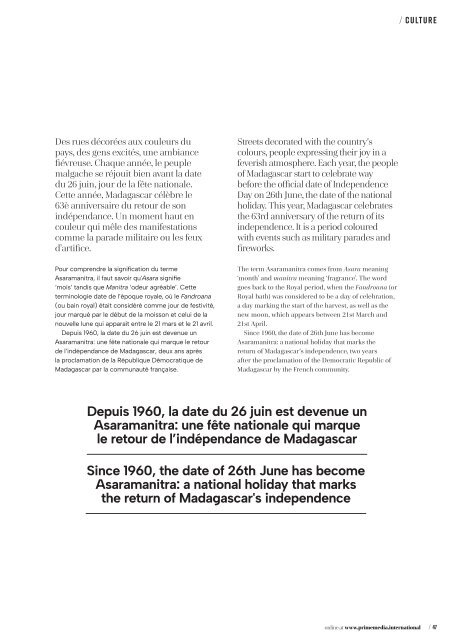Prime Magazine June 2023
Prime Magazine Madagascar June 2023 Edition
Prime Magazine Madagascar June 2023 Edition
Create successful ePaper yourself
Turn your PDF publications into a flip-book with our unique Google optimized e-Paper software.
culture<br />
Des rues décorées aux couleurs du<br />
pays, des gens excités, une ambiance<br />
fiévreuse. Chaque année, le peuple<br />
malgache se réjouit bien avant la date<br />
du 26 juin, jour de la fête nationale.<br />
Cette année, Madagascar célèbre le<br />
63è anniversaire du retour de son<br />
indépendance. Un moment haut en<br />
couleur qui mêle des manifestations<br />
comme la parade militaire ou les feux<br />
d’artifice.<br />
Pour comprendre la signification du terme<br />
Asaramanitra, il faut savoir qu'Asara signifie<br />
‘mois’ tandis que Manitra ‘odeur agréable’. Cette<br />
terminologie date de l’époque royale, où le Fandroana<br />
(ou bain royal) était considéré comme jour de festivité,<br />
jour marqué par le début de la moisson et celui de la<br />
nouvelle lune qui apparaît entre le 21 mars et le 21 avril.<br />
Depuis 1960, la date du 26 juin est devenue un<br />
Asaramanitra: une fête nationale qui marque le retour<br />
de l’indépendance de Madagascar, deux ans après<br />
la proclamation de la République Démocratique de<br />
Madagascar par la communauté française.<br />
Streets decorated with the country's<br />
colours, people expressing their joy in a<br />
feverish atmosphere. Each year, the people<br />
of Madagascar start to celebrate way<br />
before the official date of Independence<br />
Day on 26th <strong>June</strong>, the date of the national<br />
holiday. This year, Madagascar celebrates<br />
the 63rd anniversary of the return of its<br />
independence. It is a period coloured<br />
with events such as military parades and<br />
fireworks.<br />
The term Asaramanitra comes from Asara meaning<br />
‘month’ and manitra meaning ‘fragrance’. The word<br />
goes back to the Royal period, when the Fandroana (or<br />
Royal bath) was considered to be a day of celebration,<br />
a day marking the start of the harvest, as well as the<br />
new moon, which appears between 21st March and<br />
21st April.<br />
Since 1960, the date of 26th <strong>June</strong> has become<br />
Asaramanitra: a national holiday that marks the<br />
return of Madagascar's independence, two years<br />
after the proclamation of the Democratic Republic of<br />
Madagascar by the French community.<br />
Depuis 1960, la date du 26 juin est devenue un<br />
Asaramanitra: une fête nationale qui marque<br />
le retour de l’indépendance de Madagascar<br />
Since 1960, the date of 26th <strong>June</strong> has become<br />
Asaramanitra: a national holiday that marks<br />
the return of Madagascar's independence<br />
online at www.primemedia.international / 47
















